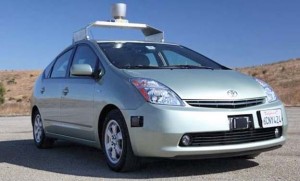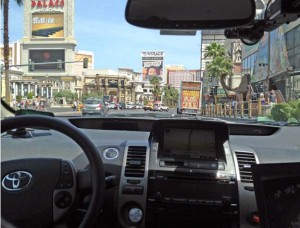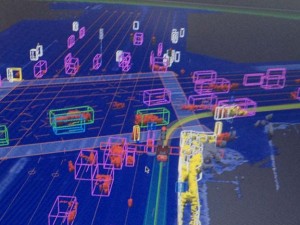There are plenty of distractions when you’re cruising the Strip in Las Vegas, from the neon lights of the big casinos to the heavy traffic along what’s officially known as Las Vegas Boulevard. And that doesn’t take into account the rolling billboards for Sin City’s seemingly ubiquitous “escort” services.
But the little Toyota Prius covered with an odd array of electronic sensors didn’t seem to notice any of it during a demonstration drive earlier this week. Or, more precisely, it only saw what it needed to in order to safely navigate a stretch that is often plagued with accidents caused by distracted human motorists.
That’s because the only humans in the Google autonomous vehicle were along for the ride, part of a demonstration showing how safe the self-guided vehicle could be. It was enough to convince the state’s Department of Motor Vehicles to issue Google the first official license for an autonomous vehicle.
Nevada is the first state in the country to pass legislation covering the use of an autonomous vehicle, though several other states are reportedly considering similar rules – while the National Highway Traffic Safety Administration is watching pilot programs, such as Google’s, with an eye towards future regulations.
During an appearance at the annual Society of Automotive Engineers convention, in Detroit, Anthony Levandowski, who oversees the Google program, said self-driving vehicles are moving out of the science fiction realm and into reality.
“I don’t think we need to wait 10 years for the next model or body styles to come out to build this technology,” he said.
That was underscored by the milestone event in Nevada this week, which earned Google the state’s first, bright red license plate reserved for autonomous vehicles. An infinity symbol represents this is technology of the future.
“I felt using the infinity symbol was the best way to represent the ‘car of the future.’” Nevada DMV Director Bruce Breslow said. “The unique red plate will be easily recognized by the public and law enforcement and will be used only for licensed autonomous test vehicles.”
The technology company has equipped a small fleet of Prius test vehicles with an array of cameras, radar and other sensors that make it possible for a human to plug in a destination and then set back and let the car do the driving. The new Nevada rules require a human onboard, just in case, and there’ll be no drinking and not-driving by the specially licensed monitor. But, so far, after logging more than 200,000 miles the Google test vehicles have experienced no crashes or other significant incidents.

Google is running a fleet of autonomous Prius hybrid test vehicles and has already clocked over 200,000 hands-free miles.
Even the rolling billboards, with images of scantily-clad women emblazoned on their sides failed to faze the test vehicle, the Associated Press noted. “They’re designed to avoid distracted driving,” DMV Director Breslow pointed out. “When you’re on the Strip and there’s a huge truck with a three scantily clad women on the side, the car only sees a box.”
High-tech safety gear, including devices using radar, laser and sonar to monitor traffic, has been credited with contributing to a sharp decline in highway fatalities. A preliminary report by the NHTSA suggests the traffic death rate in the U.S. is at its lowest level since 1949 – and on a deaths-per-100-million-miles-driven basis is lower than at any time since records were first kept in the 1920s.
(For more on the latest fatality study, Click Here.)
It’s one thing to signal when a vehicle might be stalled in your lane, however, and another to safely steer around it in heavy traffic, so despite Google’s corporate optimism it is unclear how soon you’ll be able to purchase an autonomous vehicle at your local showroom.
But the California-based tech giant has been meeting with officials from a number of automotive manufacturers, it confirms, hoping to line up partners interested in licensing its technology. Meanwhile, a variety of makers, such as Volkswagen and General Motors’ Cadillac division, are toying with their own autonomous pilot vehicles. Several are expected to seek their own red Nevada licenses in the coming months.
Once the technology does go into production, however, the state plans to issue a second special license plate in green.


